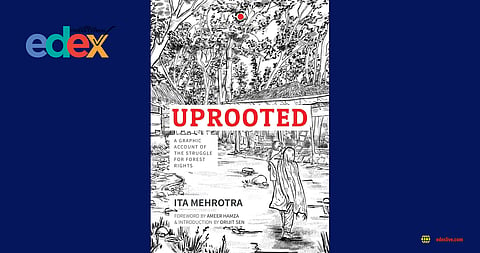

For Delhi-based comic maker and artist-activist Ita Mehrotra, Uprooted (Westland/Context), her latest graphic novel that follows the Van Gujjars, a pastoral community in Uttarakhand, didn’t begin as a “book project”. It began as a question of belonging, displacement, and what it really means to live with the forest.
As the title suggests, Uprooted explores the literal and metaphorical displacement of a community from their ancestral forests, as they face eviction and forced resettlement on agricultural land.
“The landscape is being uprooted, and so are entire communities,” says Mehrotra. “When they are moved from forest to resettlement sites, it doesn’t just shift their location, but changes their entire way of living. The Van Gujjars have historically lived with the forest, consuming its produce and migrating with their buffalo. All of that disappears when they are confined to small plots of farmland.”
The book took shape during the Covid-19 lockdown, when Mehrotra began learning about communities facing forest rights issues, extractivism, and displacement. Her research led her to work with organisations such as the Van Gujjar Tribal Yuva Sanghatan and the All India Union of Forest Working People (AIUFWP) in Uttarakhand, where she met activists and lawyers fighting for forest rights.
Her work with them brought her to the Van Gujjar community near Dehradun, where she began documenting what she was seeing and hearing. “I didn’t want to ‘depict’ their lives. It was more about having long-winded engagement in solidarity and in wanting to have associations with people and learn from the ground what’s happening,” she says. Initially, she imagined
making posters or pamphlets to support their work, but her sketches, conversations, and field notes soon grew into a story. “The book really came together organically,” she adds.
Divided into five parts, Uprooted weaves together her conversations with those still living in the forest, those resettled to agricultural lands, and activists who’ve worked in these areas, including Taungya workers in plantations constantly relocated.
The politics of presence
Mehrotra’s time in the forests was less about extracting stories and more about building trust. “I didn’t want to make them sources or case studies. That kind of extractive approach has already been done to death,” she says.
Working closely with community leaders and activists such as Roma Malik and Aamna, she spent years visiting settlements, listening, sketching, and simply being present. Some of the young women she met have since become close friends—something she says “matters beyond the book”.
The book developed over four years through her travels, fieldwork, and sketching. “I kept my sketchbook with me in the field,” she recalls. “There were a few drawings I could make on site, but the terrain was tricky—climbing hills, walking through forests. So I’d note details: a vine used to tie buffalo fodder, a leaf’s shape, a woman’s call echoing from the top of a tree.”
In several panels, Mehrotra draws herself into the frame—observing, questioning, even laughing at her own awkwardness. In one scene, she looks up at Ramzaan, a Van Gujjar woman perched high in a tree, and wonders, “How do I draw how very high up she is?”
Positioning herself within the pages, she becomes a visual guide, helping readers travel with her. “It’s about acknowledging my place,” she says. “I’m not pretending to be part of the community. I’m a city-dweller, an outsider trying to understand. Drawing myself in lets me be self-reflective in a way academic writing doesn’t. I can stand with them, but I don’t pretend to be them.”
Home and displacement
The idea of “uprootedness” threads through every layer of the book and Mehrotra ties it to India’s colonial and postcolonial history of forest management. “The forest department, created by the British, still owns vast tracts of land. It’s a continuation of extractivism, turning forests into plantations for profit,” she says. “Resettlement—whether for dams, highways, or national parks—has been sold as rehabilitation, but it’s a lie. It’s a way of controlling people, fixing them to small plots, taking away their freedom to move.”
Her time with the Van Gujjars also reshaped her understanding of home—one without walls. “The forest is a home, and the way they build their homes is very open. When you’re inside, you’re always looking out. It’s not about privacy or shutting yourself away. It’s about shelter and coexistence.”
The book also pushed her to ask: who does this country really belong to? A question she has explored before in her 2021 work Shaheen Bagh: A Graphic Recollection, around belonging and citizenship. “When I was in the Taungya settlements—workers who were brought to plantations, I realised how most people in this country don’t own the land they live on. Most Dalit and Adivasi people still don’t enjoy that right to land. A very small section of Indians enjoy that sense of entitlement to citizenship,” she says.
Uprooted becomes a visual diary that insists on seeing the land, its people, and the histories erased beneath the canopy of “development”. As Mehrotra puts it, “It’s not about showing people what’s wrong. It’s about learning how to really listen to those who’ve lived closest to the earth, and been forced to leave it behind.”
[Article by Adithi Reena Ajith of The New Indian Express]
